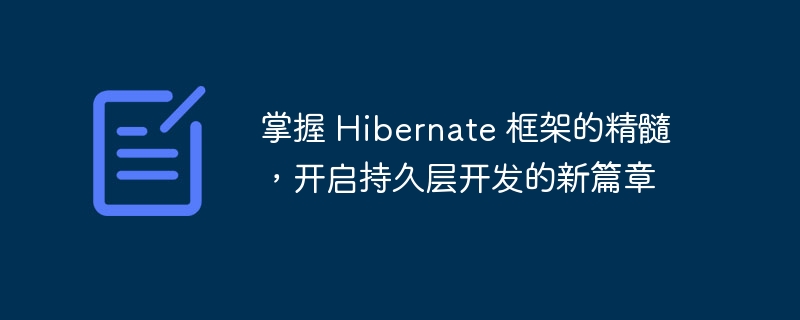

php editor Xigua will take you to explore the Hibernate framework in depth, master its essence, and open a new chapter in persistence layer development. Hibernate is an open source object-relational mapping framework that provides Java developers with convenient database operations. By learning Hibernate, you can easily achieve data persistence, improve development efficiency, and make programs easier to maintain and expand. Let's explore the mysteries of Hibernate together and add new vitality to persistence layer development!
An entity is a class of Java objects that represents a table in a database. Entity classes need to be marked with the @Entity annotation. For example:
@Entity
public class Person {
@Id
@GeneratedValue
private Long id;
private String name;
private int age;
// 省略 getter 和 setter 方法
}The primary key is the unique identifier of the entity class, which is used to distinguish different entities. The primary key field needs to be marked with the @Id annotation, and the primary key generation strategy is usually specified using the @GeneratedValue annotation. For example:
@Id @GeneratedValue(strategy = GenerationType.AUTO) private Long id;
Attribute is a field of the entity class, which represents a field in the database table. Attribute fields need to be marked with the @Column annotation and specify the field type, length and other attributes. For example:
@Column(name = "name", length = 50, nullable = false) private String name;
Mapping is the correspondence between Java objects and database tables. Hibernate uses annotations or XML configuration files to define mapping relationships. For example:
@Entity
@Table(name = "person")
public class Person {
@Id
@GeneratedValue
private Long id;
@Column(name = "name", length = 50, nullable = false)
private String name;
@Column(name = "age")
private int age;
// 省略 getter 和 setter 方法
}Before using Hibernate, you need to configure Hibernate first. You can configure Hibernate using XML configuration files or Java annotations.
SessionFactory is the core object of Hibernate. It is threadsafe and can be used by multiple threads at the same time. You need to create the SessionFactory when the application starts and destroy the SessionFactory when the application closes.
SessionFactory sessionFactory = new Configuration() .configure() // 从 hibernate.cfg.xml 文件读取配置 .buildSessionFactory();
Session is a lightweight object that represents a connection to the database. You need to create a Session when you need to interact with the database and close the Session when the interaction is complete.
Session session = sessionFactory.getCurrentSession();
You can use Session to perform CRUD (create, read, update, delete) operations.
// 创建一个新的 Person 对象
Person person = new Person();
person.setName("John Doe");
person.setAge(30);
// 将 Person 对象保存到数据库
session.save(person);
// 提交事务
session.getTransaction().commit();You need to close the SessionFactory when the application closes.
sessionFactory.close();
Hibernate is a popular ORM framework that helps you map Java objects to database tables easily. By using Hibernate, you can focus on business logic rather than underlying SQL queries.
The above is the detailed content of Master the essence of the Hibernate framework and open a new chapter in persistence layer development. For more information, please follow other related articles on the PHP Chinese website!
